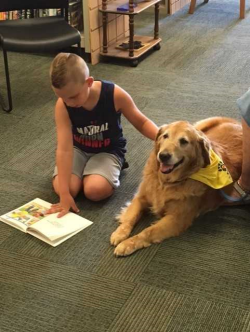Are Dogs the New Library Cat?
At Red Land Community Library in Etters, Pennsylvania, parents can sign children up for a 15-minute slot to read to a golden retriever. Ella is one of three trained therapy dogs who are among the library’s most famous and beloved volunteers. The dogs work an 11:00 am to 1:00 pm shift on Saturdays, sitting contentedly while children choose a book to read aloud.
A study by researchers at Tufts Institute for Human-Animal Interaction found that the presence of an animal during reading reduced stress for school-age children. The researchers assessed second-grade students who were assigned to a control group or to a group in which the students read to a therapy dog for 30 minutes each week. Although the students in the therapy dog group did not see higher scores in reading skill after six weeks, their attitude about academic reading improved significantly. Reading attitude is a willingness to read and an enjoyment of reading. It can have a profound impact on student’s reading and overall academic success.

But why read aloud to a dog instead of a person? When children read aloud, they gain fluency and confidence, but for readers at all levels, it can be intimidating. A dog is a quiet, patient listener, offering comfort and support, and none of the constructive criticism children may have come to associate with reading aloud. Reading to a dog is one of those secretly educational activities—so much fun that kids don’t mind learning something in the process. While the value of reading to a therapy dog is backed by research, the benefits extend even further. Karen Hostetter, Library Manager at Red Land Community Library says the therapy dogs become faithful friends to the children and staff, and the community response has been overwhelmingly positive, even among children who are afraid of dogs.
“We use it as a learning experience,” says Hostetter. “We invite them to meet our gentle dogs and model how we pet them softly and talk to them. Usually the fear turns to interest and sometimes they will even reach out to touch them timidly.”
In a library where Hostetter worked previously, one of their therapy dogs—a rescued greyhound named Cosgrove—passed away suddenly. The day she shared this with the children, she used the storytime to talk about grief. She read the book Missing Maggie by Connie S. Owens and set up a display of other children’s books on loss and grief for parents who wanted to further explore the topic with their kids. She invited the kids to share their stories about losing a pet.
Dogs in Academic Libraries
Young children aren’t the only ones who benefit from time with a therapy dog. Interacting with an animal has been shown to reduce blood pressure, lower cortisol levels, and increase oxytocin, the hormone associated with trust and relationship-building. That’s why the University of Connecticut’s Homer Babbidge Library on Storrs campus implemented the Paws To Relax program, which allows students to spend time with a therapy dog during the most stressful time of the year: finals. The stress of studying and test-taking compounds the stress that many students already experience by being away from their home-based support system—and away from their family pet. Paws To Relax brings therapy dogs of all breeds to the library, from pugs to golden retrievers to rottweilers. According to a paper published in the journal College & Undergraduate Libraries, the program it was easy to implement, and the student response was exceptionally positive.
Programs like this serve a twofold purpose: to offer students the therapeutic benefits of interacting with a dog, and to create an engagement opportunity that attracts students to the library. At the University of Colorado Boulder, students who drop by to pet a dog through the Bark Buddies program are also encouraged to schedule a research consultation with a librarian. Once students are in the door, it’s an excellent opportunity to raise awareness for the less furry, but equally valuable services academic libraries offer.
Bring Dogs Into Your Library
Interested in bringing a similar program to your library? Hostetter recommends getting in touch with organizations that train therapy dogs, such as K-Pets or Therapy Dogs International (TDI). Programs like TDI’s “Tail Waggin’ Tutors” makes it easy to bring therapy dogs to your community. But no need to worry about the fate of the library cat. According to Hostetter, the New Oxford Library in a neighboring county had a cat that children could read to, as well as a horse named Topper!
Does your library have a therapy dog or animal program, or are you considering it? Share your stories!
What is a therapy dog?
Therapy dogs are typically trained by and reside with a handler. They’re working dogs as well as their handlers’ family pet.
Dog of any age, breed, or size can become a therapy dog, including dogs with physical disabilities. A calm temperament around people and other animals is more important than physical fitness.
Therapy dogs are typically registered with a local therapy dog organization and the handler carries insurance.
Unlike service dogs, therapy dogs are not required by law to have access to public buildings.
Learn more about therapy dogs.
